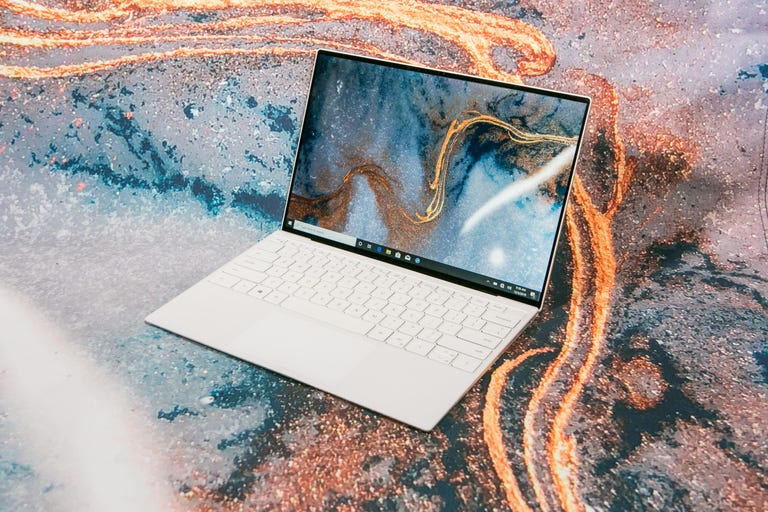 Why You Can Trust CNET
Why You Can Trust CNET Dell XPS 13 review: Tiny tweaks to a long-time favorite
With a slightly bigger screen and smaller body, the new XPS 13 continues its steady march towards laptop perfection.
Having watched the Dell XPS 13 evolve over the past several years, I really thought we had reached the end of the line in terms of possible improvements. The 2019 version had a super-slim bezel, good performance at a decent price, 4K screen options, and was more of a major step forward, solving a long-time engineering problem by putting a super-tiny webcam up on top of the screen, instead of underneath it.
Like
- Ever so slightly larger screen.
- Ever so slightly smaller body.
- More ports and connections than typical.
Don't like
- Trading up to a mainstream CPU costs more.
- I've never loved the woven texture palm rest.
And while I could no longer make jokes about the infamous up-the-nose webcam shot, I pretty much didn't have any major design complaints about the system anymore. So, where do you go from there?
You start by tweaking the screen, shaving down that bezel a tiny bit more and shaping the lid, so you can fit a 13.4-inch display in there, instead of a 13.3-inch one. That sounds like a pretty tiny tweak, and it is, but I like that it now has a very modern-feeling 16:10 aspect ratio screen. Not quite as TV-like as the 16:9 ones almost everywhere else.
The body has lost a few fractions of a millimeter, too, with a slightly smaller footprint. But the smaller body also means it feels dense when you pick it up, and slightly heavier than you expect, even though it actually weighs the same 1 pound, 13 ounces as the latest MacBook Air (without power bricks, and going by the exact test configurations I had of each). The larger footprint of the MacBook makes the weight feel more evenly distributed, but it also takes up slightly more space on your desk, so there's a trade-off.
Now that's a slim bezel.
The amazing screen-to-body ratio on the XPS 13 is a real eye-catching selling point here. For some people, the white woven glass palm rest area -- a $50 upsell over black carbon fiber -- is also a big attraction. I never thought the white palmrest and aluminum lower body felt part of an organic whole, the way some other laptops feel like they're carved from a single slab of metal (even if they're not). But my son -- hey, we're all working from home offices now, remember? -- looked at both the new XPS 13 and new MacBook Air side by side and declared the XPS to be much fancier.
In some ways, the new XPS 13 has the bad luck to arrive right around the same time as the new Apple MacBook Air, a similarly priced 13-inch laptop that covers a lot of the same ground. The new MacBook Air upgraded itself by moving to a new keyboard style, closer in fact to what's on the XPS 13. It also jumped to quad-core 10th-gen Core i5 CPUs, again, also offered in the XPS 13.
Beats a butterfly keyboard any day...
Digging into the prices and parts
These two are similar in so many ways, including some confusing pricing options to dig through. Both were originally pitched as starting at $999 in the US. The MacBook Air has indeed moved back to $999, but that drops you down to a dual-core Intel Core i3 CPU, which doesn't sound like a $1,000 part to me. The new XPS 13, as originally noted during its CES 2020 rollout, started at $999 with -- yes -- a Core i3 CPU. But as of this writing, I'm seeing $1,249 as the least-expensive option (older models are still available for significantly less) on Dell's website. That gets you a new Core i5 with Intel Iris graphics, 8GB of RAM and 256GB of storage, similar to the specs on a $1,099 2020 MacBook Air (which also has a higher-resolution screen).
My test unit was well-equipped, with a Core i7 CPU, 16GB of RAM, a 512GB SSD and a 1,920x,1,080 touchscreen display, for $1,749. To be fair, Apple did the same, sending me a higher-end Core i7/16GB/512GB build that costs $1,649.
Little surprises
While the XPS 13 originally felt like the best 13-inch Windows laptop to get if you wanted a MacBook-Air-like experience, but for whatever reason needed to run Windows instead of MacOS. But it's long since evolved past that. The component specs may match up pretty well, but the XPS is also full of pleasant subtle surprises.
The two USB-C ports (which are also full Thunderbolt 3 ports) are split up, one on each side, giving you more options for plugging in power or accessories. The MacBook Air shoves both on one side, leaving you less flexibility. The XPS 13 also includes a microSD card reader, a rare inclusion in a world where PC makers are racing to shed ports as quickly as possible.
And finally, you can't beat that nearly edge-to-edge screen. Next to it, the MacBook's display bezels look huge. Even with the 1,920x1,080 option, the 500-nit display looks great. Yes, there's a 4K option, for $200 more than the FHD touchscreen, but on a screen this size that feels like overkill, and would no doubt knock several hours off the impressive 11-hour-and-26-minute battery life we got for the XPS 13 in our video-streaming battery life test.
Some premium Windows laptops focus on cutting weight, like the LG Gram, or size, like the Acer Swift 7, but Dell has managed to make some subtle improvements to a proven winner and maintain its title as one of the best all-around general-purpose 13-inch Windows laptops you can buy.


